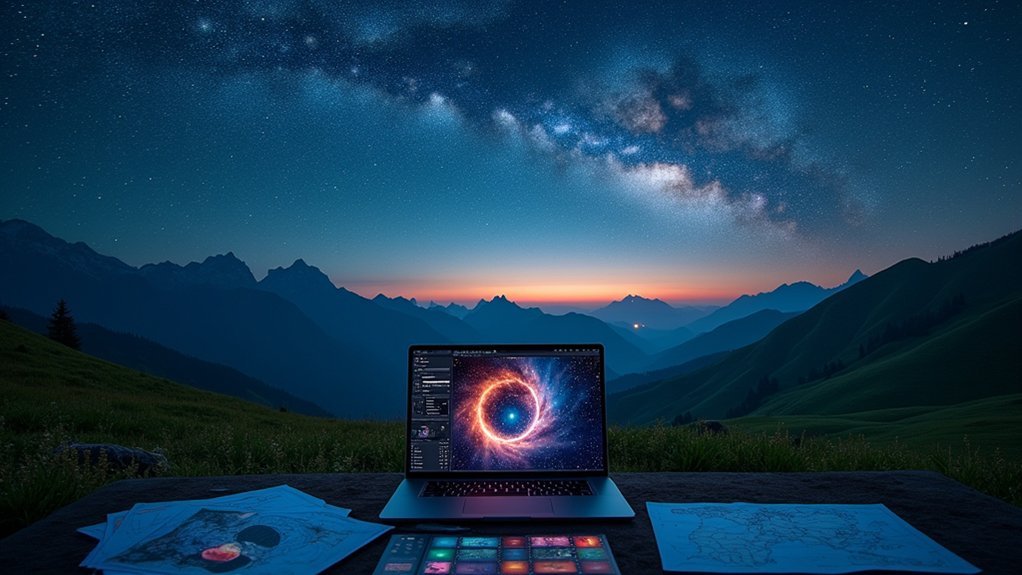You’ll get professional astrophotography results without spending a penny using these three powerful tools. SiriL efficiently stacks and processes multiple exposures, handling hundreds of frames in minutes. GIMP offers thorough editing capabilities comparable to Photoshop with non-destructive workflows. GraXpert specializes in removing gradients with an intuitive interface. All three complement each other perfectly and include extensive tutorials for beginners and experts alike. Discover how these tools can transform your cosmic captures below.
SiriL: The Powerhouse for Stacking and Post-Processing

When diving into astrophotography processing, you’ll quickly discover that SiriL stands out as the free powerhouse tool of choice. This stacking software efficiently combines multiple exposures into stunning high-resolution images while offering impressive processing speeds—handling up to 400 light frames in under 20 minutes.
SiriL’s straightforward interface doesn’t compromise on advanced features. You’ll appreciate its robust background extraction capabilities and color calibration tools when working with your RAW images. The software supports various formats, including FITS, giving you flexibility with different astrophotography projects.
SiriL’s intuitive design packs powerful background extraction and color calibration while supporting diverse formats for any astrophotography adventure.
Whether you’re a beginner or experienced photographer, you’ll find extensive online tutorials and active community support that make learning the image processing workflow accessible.
For free post-processing software that delivers professional results, SiriL deserves a place in your photo editing toolkit.
GIMP: A Comprehensive Free Alternative to Photoshop
While SiriL excels at stacking, GIMP emerges as the all-encompassing solution for your final astrophotography edits. This powerful open source image editor delivers advanced features comparable to Photoshop without the subscription cost.
You’ll appreciate GIMP’s support for critical file formats like FITS, TIFF, and JPEG when working with high-dynamic-range celestial images. The software’s non-destructive editing capabilities guarantee your original data remains intact while you experiment with multiple adjustments.
Take advantage of GIMP’s layers, masks, and filters to refine contrast and enhance color balance in your cosmic captures.
Even as a beginner, you won’t feel lost—extensive online tutorials and an active community provide guidance as you master this versatile tool.
For astrophotographers seeking professional-grade results on a budget, GIMP delivers exceptional value.
GraXpert: Specialized Gradient Removal Made Simple

Although many editing tools offer gradient correction, GraXpert stands out as a free, open-source application dedicated exclusively to this critical aspect of astrophotography.
You’ll appreciate its compatibility with FITS, TIFF, and JPEG formats while working on your deepsky images.
GraXpert’s approach to gradient removal is intuitive—create sample points that identify background sky areas while avoiding stars and galaxies, then hit the Calculate Background button to effectively reduce gradients.
This precision dramatically improves image quality with minimal effort.
The software’s ability to save processed images in auto-stretched format streamlines your editing workflow.
As a standalone application available for Windows, Mac, and Linux, it’s accessible regardless of your experience level.
If you need guidance, the user-friendly interface is supplemented by an extensive video tutorial and PDF manual.
Frequently Asked Questions
How to Edit Astrophotography for Free?
You can edit astrophotography for free using GraXpert for gradient reduction, SiriL for stacking, GIMP for detailed editing, StarNet++ for star reduction, and DeepSkyStacker for pre-processing your celestial images.
What Is the 500 Rule in Astrophotography?
The 500 rule helps you avoid star trails in astrophotography. Simply divide 500 by your lens’ focal length to find the maximum exposure time in seconds. It’s your starting point for capturing sharp stars.
Is the Astrophotography Tool Free?
The Astrophotography Tool (APT) isn’t completely free. You’ll get a 30-day trial to test its features, but after that, you’ll need to make a one-time payment to continue using it.
What Is the Best Editing Software for Astrophotography?
The best astrophotography editing software depends on your needs. SiriL excels at processing large image sets, while GraXpert removes gradients effectively. DSS is great for beginners, and GIMP provides powerful post-processing capabilities.
In Summary
You’ve just discovered three powerful free tools to elevate your astrophotography. SiriL handles your stacking and post-processing needs, GIMP offers a complete Photoshop alternative, and GraXpert tackles those frustrating gradients. Whether you’re a beginner or an experienced astrophotographer, these applications will dramatically improve your cosmic images without costing you a penny. Start experimenting with them today and watch your celestial photos transform!





Leave a Reply